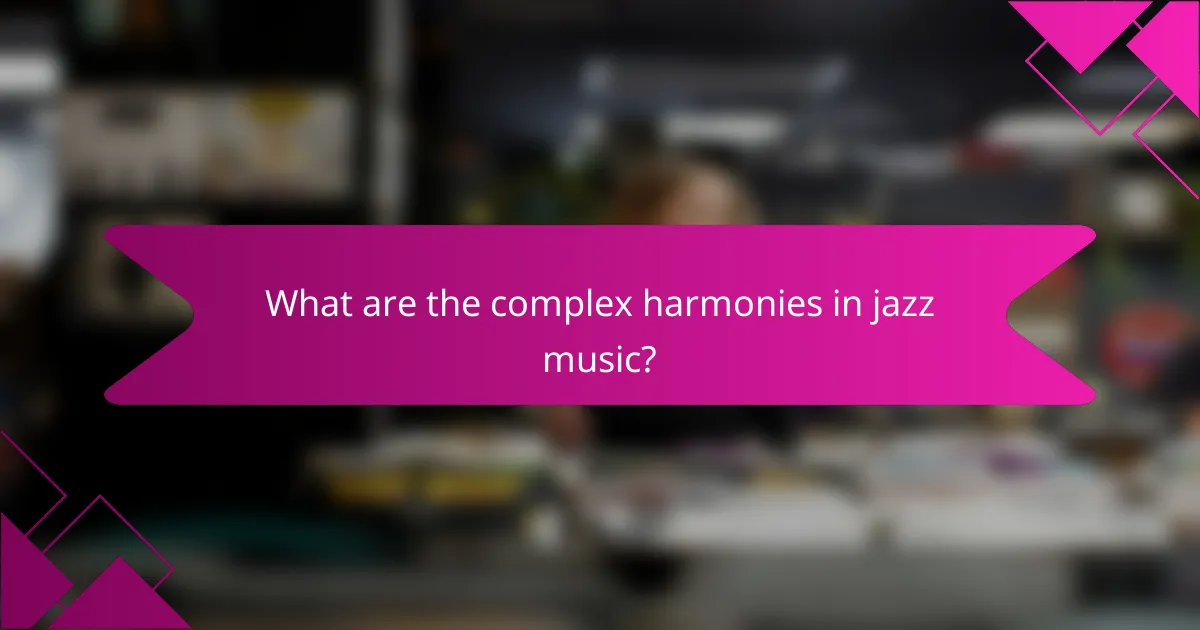Jazz music is a vibrant genre characterized by its emphasis on improvisation, allowing musicians to craft spontaneous melodies and harmonies that make each performance distinct. The use of complex harmonies, including extended and altered chords, enriches the soundscape and enhances emotional expression. Influenced by African rhythms, blues, and European classical music, jazz embodies a diverse musical heritage that continues to inspire creativity and innovation.

How does jazz music incorporate improvisation?
Jazz music incorporates improvisation by allowing musicians to create spontaneous melodies and harmonies during performances. This dynamic approach fosters creativity and personal expression, making each performance unique.
Spontaneous composition
Spontaneous composition in jazz refers to the ability of musicians to generate new musical ideas on the spot. This often involves building upon existing themes or chord progressions, enabling artists to explore different musical directions without pre-planning. For example, a soloist might take a familiar tune and alter its melody or rhythm, creating a fresh interpretation.
To effectively engage in spontaneous composition, musicians should develop a strong understanding of music theory and practice their instrument regularly. Familiarity with various scales and modes can also enhance their improvisational skills, allowing for more fluid and creative expressions.
Call and response techniques
Call and response techniques are a fundamental aspect of jazz improvisation, where one musician plays a phrase (the “call”) and another responds with a complementary phrase. This interaction can create a conversational feel within the music, fostering collaboration among performers. For instance, a trumpet might play a short melody, followed by a saxophone echoing or expanding on that idea.
This technique encourages active listening and engagement among musicians, making it essential for them to be attuned to each other’s playing. Practicing this method can help develop timing and musical dialogue, which are crucial for effective improvisation.
Use of motifs
The use of motifs in jazz involves repeating short musical phrases or ideas throughout a performance. These motifs serve as building blocks for improvisation, allowing musicians to elaborate and vary them in different ways. For example, a pianist might introduce a simple motif, which the other instruments can then interpret or transform in their solos.
Motifs can help establish a cohesive sound within a piece, providing a familiar reference point for both musicians and listeners. To utilize motifs effectively, musicians should focus on varying elements such as rhythm, dynamics, and harmony while maintaining the core idea. This approach can enhance the overall texture and depth of the performance.

What are the complex harmonies in jazz music?
Complex harmonies in jazz music involve the use of extended, altered, and modal interchange chords, which create rich and varied soundscapes. These harmonies allow musicians to explore a wide range of emotional expressions and improvisational possibilities.
Extended chords
Extended chords are chords that include notes beyond the standard triads, typically adding the seventh, ninth, eleventh, or thirteenth notes. For example, a Cmaj7 chord includes the root, third, fifth, and seventh, while a C9 chord adds the ninth. These chords enrich the harmonic texture and provide a more colorful sound.
When using extended chords, musicians often experiment with voicings to create unique sounds. A common practice is to omit certain notes, like the fifth, to emphasize the more colorful extensions. This approach allows for greater flexibility in improvisation and enhances the overall harmonic complexity.
Altered chords
Altered chords are variations of standard chords where one or more notes are modified, typically the fifth or ninth. For instance, a G7 chord can become G7#5 or G7b9, introducing tension that can resolve beautifully in a progression. These alterations create a sense of movement and anticipation, essential in jazz improvisation.
Jazz musicians often use altered chords to navigate through changes and create a more dynamic sound. It’s crucial to understand how these alterations affect the overall harmony and to practice resolving them effectively to maintain musical coherence.
Modal interchange
Modal interchange involves borrowing chords from parallel modes, such as using chords from C minor while in the key of C major. This technique adds unexpected colors and emotional depth to a piece, allowing for greater expressive range. For example, incorporating an Eb major chord in a C major context can evoke a different mood.
When applying modal interchange, it’s important to consider the overall tonality and how borrowed chords will fit within the existing harmonic structure. Musicians should experiment with different modes to discover new sounds and enhance their improvisational skills. Understanding the relationships between modes can lead to innovative harmonic progressions and fresh musical ideas.

What diverse influences shape jazz music?
Jazz music is shaped by a variety of influences, including African rhythms, blues elements, and European classical music. These elements combine to create the genre’s unique sound characterized by improvisation and complex harmonies.
African rhythms
African rhythms play a crucial role in the foundation of jazz music. The use of polyrhythms, syncopation, and call-and-response patterns reflects traditional African musical practices. These rhythmic elements contribute to the dynamic and lively nature of jazz performances.
Musicians often incorporate complex drum patterns and percussive instruments, which create a rich tapestry of sound. This rhythmic diversity allows for spontaneous improvisation, a hallmark of jazz.
Blues elements
The blues is a significant influence on jazz, providing emotional depth and a distinct musical structure. Characterized by its use of the twelve-bar blues form and blue notes, the blues serves as a foundation for many jazz compositions and improvisations.
Jazz musicians frequently draw on the expressive qualities of the blues, using techniques like bending notes and employing a soulful vocal style. This connection enhances the emotional resonance of jazz, making it relatable and impactful.
European classical music
European classical music contributes to jazz through its complex harmonies and formal structures. Elements such as counterpoint and orchestration can be found in jazz arrangements, enriching the genre’s harmonic language.
Jazz musicians often study classical techniques, allowing them to incorporate sophisticated chord progressions and intricate melodies into their work. This blending of styles results in a diverse musical landscape that appeals to a wide audience.

How does jazz music evolve in major cities?
Jazz music evolves in major cities through a blend of cultural influences, innovative styles, and local traditions. Each city contributes unique elements that shape the genre, resulting in diverse expressions of jazz across different urban landscapes.
New York City jazz scene
The New York City jazz scene is renowned for its vibrant atmosphere and rich history. It serves as a melting pot where various styles, such as bebop, hard bop, and avant-garde, converge. Venues like the Village Vanguard and Blue Note are iconic spaces where both established and emerging artists showcase their talents.
Musicians in New York often experiment with improvisation and complex harmonies, pushing the boundaries of traditional jazz. The city’s cultural diversity also influences the music, incorporating elements from Latin, African, and Caribbean traditions, creating a unique sound that reflects its cosmopolitan nature.
Chicago jazz history
Chicago has a storied jazz history that significantly shaped the genre in the early 20th century. The city became a hub for musicians migrating from New Orleans, leading to the development of styles like Chicago blues and swing. Notable venues such as the Green Mill Cocktail Lounge continue to celebrate this legacy.
Chicago jazz is characterized by its emphasis on improvisation and collective playing. The city’s musicians often focus on storytelling through their music, using complex harmonies and rhythms to convey emotions and experiences, which resonates with audiences both locally and globally.
Los Angeles jazz fusion
Los Angeles is known for its innovative approach to jazz, particularly in the realm of jazz fusion. The city blends jazz with rock, funk, and electronic music, creating a sound that is both contemporary and diverse. Artists like Herbie Hancock and the band Weather Report have been pivotal in this evolution.
The LA jazz scene encourages collaboration across genres, leading to unique performances that often incorporate visual arts and multimedia. This fusion not only attracts a broader audience but also fosters creativity among musicians, allowing for a dynamic exploration of jazz’s possibilities.

What are the criteria for selecting jazz instruments?
Selecting jazz instruments involves evaluating their sound quality, versatility, and how well they fit within the ensemble. These criteria ensure that musicians can effectively express the improvisational and harmonic complexity characteristic of jazz music.
Sound quality
Sound quality is crucial when choosing jazz instruments, as it directly impacts the overall musical experience. Instruments should produce a rich, dynamic tone that can convey the emotional depth of jazz. For example, a saxophone’s warm timbre can enhance a solo, while a piano’s bright sound can drive the rhythm.
When assessing sound quality, consider the instrument’s material and construction. Woodwinds often have a softer, warmer sound, while brass instruments tend to be brighter and more piercing. Testing instruments in various settings, such as solo performances and ensemble play, can help determine their suitability.
Versatility
Versatility is another key factor in selecting jazz instruments, as it allows musicians to adapt to different styles and settings. An instrument that can perform well across various genres—like blues, funk, or bebop—offers greater opportunities for collaboration and improvisation. For instance, a guitar can easily switch between rhythm and lead roles, making it a popular choice in jazz ensembles.
When evaluating versatility, consider the range of techniques and sounds an instrument can produce. Instruments with adjustable settings or those that can be played in multiple ways, such as a keyboard, can enhance a musician’s ability to explore diverse musical ideas. Additionally, look for instruments that are commonly used in various jazz subgenres to ensure compatibility with different groups.
